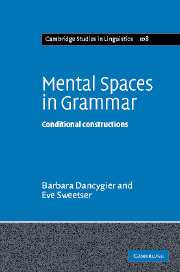Book contents
- Frontmatter
- Contents
- Acknowledgments
- Preface
- Note on abbreviated citations
- The door-scraper in the Wild Wood: an informal lesson in frame metonymy
- 1 Conditional constructions, mental spaces, and semantic compositionality
- 2 Prediction, alternativity, and epistemic stance
- 3 Tense, epistemic distance, and embedded spaces
- 4 Future and present forms in conditional constructions
- 5 Non-alternatives and alternatives: mental spaces in different domains
- 6 Then and even if: mental-space deixis and referential uniqueness
- 7 Clause order and space building: if, because, unless, and except if
- 8 Uniqueness and negative stance: only if and if only
- 9 Coordinate constructions and conditional meaning
- 10 The door-scraper in the Wild Wood: conditional constructions and frame-based space building
- References
- Author index
- Subject index
10 - The door-scraper in the Wild Wood: conditional constructions and frame-based space building
Published online by Cambridge University Press: 22 September 2009
- Frontmatter
- Contents
- Acknowledgments
- Preface
- Note on abbreviated citations
- The door-scraper in the Wild Wood: an informal lesson in frame metonymy
- 1 Conditional constructions, mental spaces, and semantic compositionality
- 2 Prediction, alternativity, and epistemic stance
- 3 Tense, epistemic distance, and embedded spaces
- 4 Future and present forms in conditional constructions
- 5 Non-alternatives and alternatives: mental spaces in different domains
- 6 Then and even if: mental-space deixis and referential uniqueness
- 7 Clause order and space building: if, because, unless, and except if
- 8 Uniqueness and negative stance: only if and if only
- 9 Coordinate constructions and conditional meaning
- 10 The door-scraper in the Wild Wood: conditional constructions and frame-based space building
- References
- Author index
- Subject index
Summary
“Now,” says you, “that door exists, as plain as if I saw it. There's nothing else remains to be done but to find it!”
(From Chapter 3, The Wind in the Willows, 1908, by Kenneth Grahame)We will conclude our book with a summary of our findings, and the placement of those findings in their cognitive context. We will first revisit the descriptive parameters which we have found necessary for distinguishing conditionals from each other and from other adverbial constructions in English. We hope that these parameters may be useful not only in understanding these English constructions, but also in building up a crosslinguistic and comparative understanding of functionally and/or formally similar constructions in general. Since some of these parameters are relatively orthogonal to each other, in many cases their markers make compositional contributions to the meaning of larger constructions. In other cases, as we have seen, a construction as a whole must be examined to identify the form with its conditional meaning.
To conclude our analysis, we shall step back from conditional constructions in particular and consider our findings against the broader backdrop of the kinds of cognitive processing strategies involved in non-compositional or partially compositional constructional semantics. Such processing is not restricted to conditional constructions – nor indeed to language itself. Recognition of these broader cognitive patterns, and their reflection in linguistic frame structures and non-compositional units, permits generalizations and brings to light regularities that would otherwise remain elusive.
- Type
- Chapter
- Information
- Mental Spaces in GrammarConditional Constructions, pp. 269 - 277Publisher: Cambridge University PressPrint publication year: 2005



